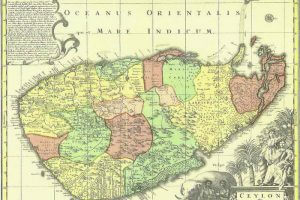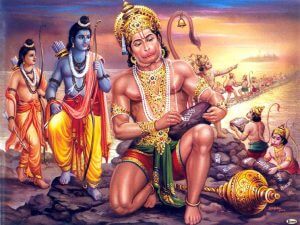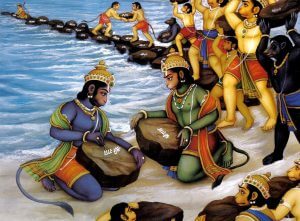
India: Mysteries of Rama Bridge
 7
7
 20. 08. 2017
20. 08. 2017

India and Sri Lanka (Ceylon) have long been associated with a mysterious shallow, which both Muslims and Hindus consider to be a human-made bridge. Relatively recent Indian geologists have determined that in fact, the artificial structure is unique in terms of its length, which is fifty kilometers, and the colossal volume of work done.
According to legend, the bridge was built by monkeys from Hanumán's army, who were real giants, as they measured about eight meters. So it was in the power of these giants to build such an incredible bridge.
Mysterious shallowness
The mysterious shoal is easily recognizable from the plane and is also captured in images from space. Muslims know it as Adam's, Hindus know it as Rama's bridge. It is interesting that on medieval Arabic maps it is marked as a real bridge, which was located above the water level and could be crossed from India to Ceylon at that time by anyone, be it a man, a woman or a child. It is remarkable that the length of this bridge is about fifty kilometers, with a width of one and a half to four kilometers.
It was preserved in good condition until 1480, when it was relatively severely damaged by a strong earthquake and the subsequent tsunami. The bridge descended significantly and was destroyed in places. Now most of it is under water, but you can still walk on it. It is true that there is a small Pamban canal between Rameswaram Island and Cape Ramnad, with small merchant ships that need to be crossed. But those of the adrenaline athletes who decide on such a risky adventure must reckon with the fact that there is a fairly strong current that can take them to the open sea.
According to Hindus, the bridge was actually built by human hands, and in the distant past it was built by an army of monkeys led by Hanuman at the behest of King Rama. This is mentioned in the sacred book of Ramayana. The same mentions can be found in the Puranas (Indian sacred books) and in the Mahabharata. This bridge forces ships to circumnavigate Sri Lanka, which represents a considerable loss of time (about thirty hours) and high fuel consumption. Therefore, it has already been proposed several times to break through the channel. Fortunately, no construction took place in the 20th century.
It was seriously considered in the 21st century, when a special corporation was created because of its construction.
And this is where the unexplained events began to take place. It was enough to start work and the excavators were decommissioned one by one. The teeth of their spoons were breaking, their engines were burning, the ropes were cracking. The corporation's debacle was completed by an unexpected storm that scattered construction ships like grains of sand, thus definitively interrupting work. Hindu believers did not doubt that the failure of canal construction was caused by unnatural causes. In their view, it was Hanuman the king of monkeys who did not allow his work to be destroyed.
Since 2007, a campaign has been underway in India under the slogan "Save Rama Bridge". Its activists protect this bridge not only as an ancient historical monument, but they believe that it is very important for the preservation of the local ecosystem. The bridge is said to have somewhat reduced the effects of the 2004 tsunami, saving many lives. Of course, the main question is whether it is really an artificial structure. If a positive answer is given, further questions will arise. Who built it and when?
The sensational discovery of Indian geologists
Although surprising, it can be reasonably assumed that the bridge is truly artificial. The depth around it is ten to twelve meters at a very significant width - just to remind you that it is from one and a half to four kilometers. It is even very difficult to imagine how huge a volume of building material had to be relocated during such titanic work! A few years ago, NASA published images of the bridge from space and clearly shows the real bridge. By the way, NASA specialists do not think that these images can shed light on the origin of this wonderful formation.
Much more convincing evidence of the artificial origin of the Rama Bridge was obtained by specialists from the Geological Survey of India GSI.
They performed an extensive study of both the bridge and the bedrock. Because of this, they drilled not only into the bridge itself, but also a hundred holes next to it and carried out geological research. It was possible to determine that the formation is not a natural elevation of the original rocks, as might be expected, but it is an obvious anomaly of an artificial nature. According to the research, the bridge was created by an embankment of stones of a fairly regular shape measuring 1,5 x 2,5 meters.
The main proof that the bridge is artificial is the fact that the embankment of stones lies on a thick layer of sea sand with a thickness of three to five meters! According to data from boreholes, the original rocks only begin below this layer of sand. It seems that someone laid a gigantic amount of limestone on it a long time ago. The regularity of the storage of this material also shows its artificial origin. Geologists also determined that there was no collection of the seabed in the area occupied by the bridge. So their scope is: Rama's bridge is undoubtedly an artificial structure!
Did the bridge build a bridge?
When and by whom was it built? If we believe the legends, it originated a million years ago, and some Western researchers even claim that it is seventeen million years old. There are also less impressive assumptions, and according to them, the bridge is either twenty thousand or three and a half thousand years old. The last digit is, in my opinion, unlikely, because it assumes that the bridge was built by people who resembled us. Why should they devote strength and time to such a width of the bridge?
It is clear that they would be satisfied with a maximum of two hundred meters. So the bridge was not built by ordinary people and is therefore probably older than just three and a half thousand years.
According to legend, it was built by monkeys from Hanumánov. And these giants were able to create such an unreal bridge. By the way, it was created so that Rama's army could reach Sri Lanka and fight its ruler there, the demon Ravana, who had kidnapped Rama's beloved Sita. It is possible that the width of the bridge was widened with respect to military targets to suddenly provide a concentrated attack on the enemy. It has long been known that it is much easier to hold an opponent moving on a narrow bridge, gorge or passage, and only a small amount of force is needed.
But if we believe the hypothesis that Sri Lanka was once part of the continent of Lemuria, then this bridge could also be built by the Lemurians, who also reached great heights. In any case, we cannot yet consider all the secrets of this bridge revealed.








